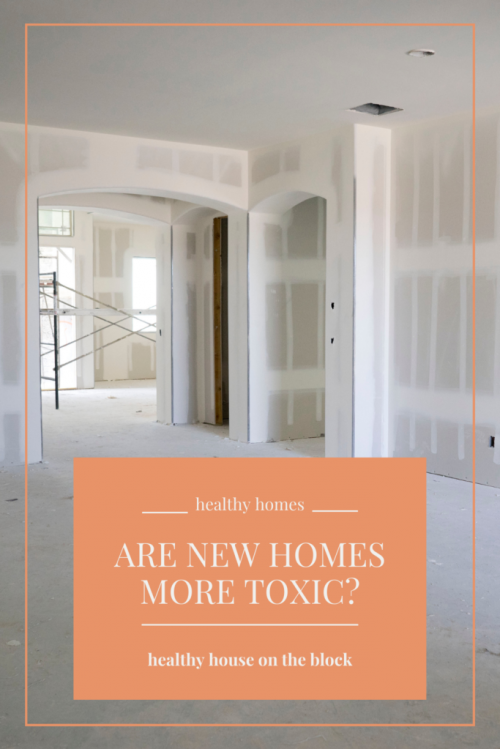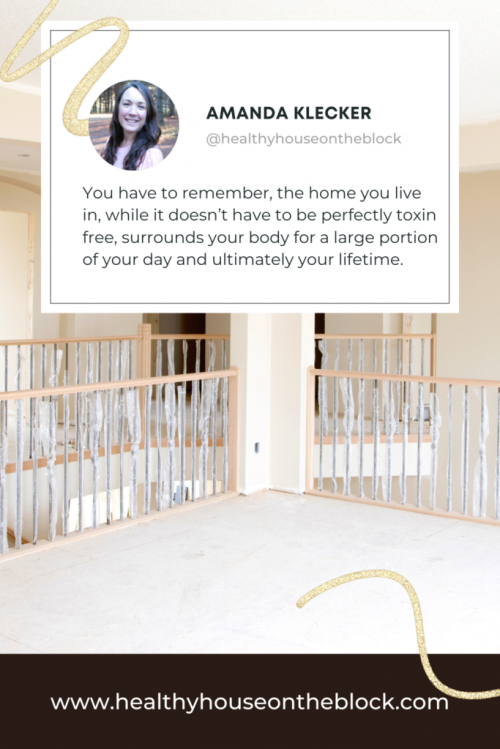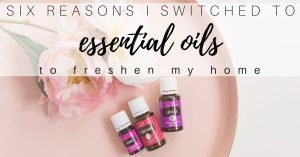
Even if you haven’t walked through a brand new home, you probably are familiar with at least the smell of new carpet. It’s a very distinct smell that has become associated with all kinds of new construction materials from floors, to paint to cabinets. It’s the smell that screams new home and newly renovated — never lived in. But that smell is also synonymous with VOCs, toxins and a lot of off gassing happening in the space.
I often get asked if new homes are better health-wise than an older home. And because every older home is completely different and every builder uses different new construction techniques to build their new home, it’s a question that can’t be answered with a simple yes or no. Just like anything we consider in terms of a healthy house, there’s options to weigh out when it comes to deciding to move into a new home. While overthinking any choice and stressing over it is not the goal, it IS important to logically weigh the options of new home vs. established home.
You have to remember, the home you live in, while it doesn’t have to be perfectly toxin free, surrounds your body for a large portion of your day and ultimately your lifetime. A space that has few VOCs off gassing is a space that allows your body to thrive, naturally. In contrast, a new home that has formaldehyde and other VOCs constantly off gassing at high levels, is a space that causes our body to constantly detox more than it can handle.

Our bodies naturally detox the environmental toxins that surround us constantly. Our systems are always working to get rid of the chemicals we come in contact with as a way of protecting our major organs and systems. When we’re “overexposed” to high levels of chemical toxins, our body just can’t work fast enough to detox naturally. This is when toxins start to build up within our systems. When this happens the trickle down effect leads to sluggish hormone production, an overworked immune system and causes an overwhelming unwell feeling.
Oftentimes it happens so gradually we don’t even notice the unwell feeling. But I think you’ll be surprised at just how much your home actually affects how you feel and how your body operates on a daily basis.
In today’s post I’ll be covering the facts behind new homes and off gassing, as well as:
- Is a new home more toxic than an older home?
- What is off gassing and how does it affect my home?
- The healthiest ways to move into a new home
- How to reduce new construction toxins long term

IS A NEW HOME MORE TOXIC THAN AN OLDER HOME?
A question I get asked ALL THE TIME. And it really truly does depend (doesn’t everything depend upon something with these topics?). But, in short, probably, yes, a new home is more toxic than an older one for a number of reasons.
VOCS: Volatile Organic Compounds are everywhere. Trees outside give off VOCs outdoors, in fact. But the difference is the VOCs inside our homes have no place to escape. Instead of dissipating outside, VOCs inside our home become trapped and more concentrated. Formaldehyde, one of the most common VOCs is in a number of building products from engineered wood to carpet.
Indoor VOC exposure has been linked to pulmonary diseases including asthma and COPD (chronic obstructive pulmonary disease). The age group most affected by asthma were those ages 1 – 18 by more than double.
Indoor VOC exposure has also been linked to an increased risk in developing certain types of cancers and negatively affects the neurological system.
CURING & DRYING: VOCs are typically off gassing the most while a product or solvent is curing or drying. THis is why wet paint smells so strongly and as it dries the odor becomes less and less. The truth is, however, that some products we think have fully cured or dried actually have not. Some building materials can take weeks up to a month to FULLY cure and dry out. This means that the off-gassing coming from these new home materials are at their absolute highest levels. As the products continue to dry, cure and age, generally the off-gassing becomes less and less in new construction. The initial 12 months of a home will produce the absolute highest levels of VOCs in the home’s lifetime.
SQUARE FOOTAGE COMPARED TO TOXINS: When you think about the square footage of a home in comparison to the new construction materials brought in, the ratio is quite equal. This is in comparison to a home construction project like finishing a basement, where the new construction materials are a small portion of the home’s total square footage.
When toxins are across nearly all the square footage of the home, the concentration of toxins is higher. This means a new home that has new plywood, new counters, new flooring, new paint and new insulation has much more off gassing happening per square foot than a home that is adding just one new component.

CONSTRUCTION DUST: The fine particles of dust that come along with any home project end up in the HVAC system and ductwork, no matter how well the home is cleaned after construction is done. The dust particles will contain toxins from flooring fibers, drywall, engineered wood, insulation and dust from cut wood and flooring. The dust will continue to travel around the house for a period of time after construction until it can all get filtered out through a furnace filter or air purifier. Meanwhile, you end up breathing in these toxins when inside the home.
ENERGY EFFICIENCY: A new home is created to be MUCH more energy efficient in comparison to its counterpart built even 10 – 20 years ago. While energy efficiency is great for reducing a carbon footprint and your wallet, it can mean that toxins get trapped inside and have no place to get out. It also means that fresh air isn’t coming inside to dilute the indoor air either. Extremely energy efficient homes can also create a negative air pressure inside, which can lead to high radon levels getting pulled inside the home through the lowest level.
But there are ways that newer homes have some really healthy components that older homes just don’t have.
RADON MITIGATION: Depending on what state you live in, many homes have made it required and mandatory to build new homes with radon mitigation systems (either passive or active) installed. In Minnesota, radon mitigation systems have been required since 2009. Any home built before this will likely not have any sort of radon system.
Radon is the number one cause of lung cancer in non-smokers and it is highly carcinogenic to those with any sort of weakened respiratory system and children. Radon is more prevalent in older homes due to the cracks naturally found in the foundation walls. If an older home his then renovated, the radon levels can be drastically raised due to negative air pressure.

ASBESTOS & LEAD FREE MATERIALS: All materials used in new construction and new homes are required to be free from lead and asbestos. This just wasn’t the case in older homes. Many homes built anytime before the 1970s can contain lead paint, lead pipes, asbestos insulation, asbestos floor tiles and asbestos ceiling tiles.
Lead is extremely harmful to children as it builds up in their systems causing problem with slowed growth, lower IQ, behavior problems, anemia and hyperactivity. Even in adults, lead exposure can lead to decreased kidney function, reproductive problems and increased blood pressure. (EPA INFORMATION)
Asbestos is a cancer causing material (ASBESTOS STUDY) that can be present in many different areas of an old house. Asbestos exposure has been linked to lung cancer and abdominal cancer as well as mesothelioma (ASBESTOS RESEARCH).
AIR EXCHANGERS: One of the BEST additions to new homes, in my opinion, is an air exchanger system. These can also be retrofitted to older homes, but in new homes they are installed immediately upon construction. These systems not only bring in fresh air from outside, but it is filtered as it comes in to prevent dirt and dust from entering your space as well. The system then takes indoor air and pumps it outside through a vent, quite literally exchanging the air inside your home.
When used properly, air exchangers can reduce VOCs, radon and other toxins inside the home that contribute to indoor air quality. The trick with air exchangers, however, is that the filters MUST be cleaned. If the filters aren’t clean, they can actually cause negative air pressure in the home, which can increase toxins including radon.
ENERGY EFFICIENT REMODEL = HIGHER VOCS THAN NEW HOMES: A study done in Switzerland tested VOCs in both new construction homes and homes that were remodeled to be energy efficient. Overall, the energy renovated homes had higher levels of most VOCs, even compared to newly built homes. The homes that were remodeled were originally built between 1950 and 1990. Those with attached garages had particularly high levels of VOCs in the home. This tells us that when energy efficient improvements are made to older homes, it’s also necessary to pair that with actions that will reduce VOC exposures in the home well.
WHAT IS OFF GASSING & HOW DOES IT AFFECT MY HOME?
Off gassing is the release of chemicals from a substance in vapor form. Odor is often a tell-tale sign of off gassing, but even after the odor has dissipated, the material is likely still off gassing. After the initial off gassing with odor, however, the material is off gassing less than in the beginning.
Off gassing of VOCs in an environment with higher levels of humidity (above 35%) have been shown to affect the human body and specifically it’s cells in a more harmful way than in drier environments. (STUDY). They found that not only are there higher concentrations of VOCs in a humid environment, but our bodies actually absorb the toxins more quickly and at higher rates as well.
Toxins also off gas at a higher level due to increased heat. A warm home will encourage more off gassing from materials as opposed to a cool, dry home. The warmer an environment is, the more materials will off gas into the air, especially at the beginning of the home’s life.
It’s important to remember that not all toxins are VOCs, and so not all toxins will off gas. Most toxins in building materials are either plastic toxins or VOC toxins. Both of these types of toxins are unhealthy, but toxins that off-gas have a higher potential for issues as they directly affect your indoor air quality. The number of different VOCs that are present in the world, is vast and seemingly never-ending . Each VOC can have negative effects on various parts of your health and wellness. Most commonly, VOCs cause hormone disruption, an increased risk of cancer and neurological issues.

HOW TO REDUCE NEW CONSTRUCTION TOXINS
There are some tactics you can use to protect you and your family while moving into a new home, which may contain more toxins:
Wait It Out: If at all possible, wait at least 30 days after construction is complete to move into your home. This is especially true if you are using Pex Piping in your new home, which can leach some toxins into your water at high levels during the first 30 days after install. While you’re waiting to move into your space, try to have your home opened up as much as possible to allow complete air exchanges to be happening constantly.
Constant Ventilating: Use your vented fans, your air exchanger, whole house fan and ceiling fans to get air moving and out of your home constantly. The more you use these systems right away, the quicker you’ll be able to get the VOCs out of your house as they are off-gas. (just make sure you’re replacing filters in your HVAC unit and air exchanger much more frequently during this high level of use.
Air Purifier: Air purifiers can help catch particles that VOCs have adhered to and construction dust. I highly recommend Medify Air MA-115 for bedrooms where you spend a long period of time. Medify Air purifiers will capture such small particles and trap them in its filter, removing them from your air forever.
If you can only afford one air purifier, just move it from room to room over a few day period and then start back over again. It’s important to remember to replace your filter frequently during these first months. With all the particles it will likely be picking up, the filter can get clogged more quickly, making it not as efficient.
Replace Air Filters Frequently: AIr filters have a set surface area to collect particles and debris from your indoor air. The more dust and particles that are in your air, the more quickly the filter surface will get plugged and clogged from those particles. In the first year of your home being built, it’s not a bad idea to replace your filters in your HVAC system and air purifier every 2 months or so.
I like to purchase a box of air filters and then keep them by my filter so that I don’t run out or have an excuse not to change it when it’s time.
You’ll also want to wash your air exchanger filters on a pretty regular basis to prevent clogging from the large amount of toxic dust getting trapped.

Remove Dust Professionally: Again, that dust is going to be fine particles and extremely toxic due to the materials used to build a new home. Believe me when I tell you that you can clean multiple times and STILL there will be drywall dust and fine dust particles in your home and on your surfaces. This is a time when sometimes I recommend referring to a professional to clean out your duct system and get the debris and fine dust out that way.
You can also hire a company to do a thorough cleaning and use a pressurized fan to remove all the dust and debris from your home in a very safe and efficient way.
Try a Bake Out: The last resort, and often a tactic used if you just can’t get rid of a toxic smell in your home is the bake out method. It’s essentially creating an extremely hot environment for the toxins to off gas at high rates in a controlled environment prior to moving inside.
There has been evidence that the bake out method does work at least a little bit to reduce off gassing down the road. It speeds up the process, and so what’s left are still toxins, but they off gas at a rate that is extremely low, as if it were an older product or material.
A bake out requires you to raise the indoor air temperature to an extreme for 2-3 days while completely ventilating 6-7 times over the course of those days. However, flushing out VOCs through ventilation is much more effective.
Seal it Off: A product like AFM SafeCoat can seal in and block VOCs from off gassing into a new home as well. They now make products for everything from plywood to finished surfaces and even carpet. This method will require a lot of work, but it’s worth it in the long run when purchasing a new home.

While purchasing a new home is likely less healthy than purchasing an older home, it doesn’t mean that there aren’t ways you can work around this to make it a healthier space. By reducing toxic VOCs that off gas in your new home, you can help create an indoor space that supports your health and wellness.




Excellent information. Having lived for many years in one location, I had forgotten about off-gassing. Within two weeks of moving into this newly renovated apartment; constant headache, coughing, and worst of all, the debilitating lethargy, in this extremely healthy person, has finally made me sit up and take notice.
Outside temperature has dropped below freezing for a good portion of the day, so windows were closed. Not anymore. Twenty minutes of fresh air coming in, and fans on; the headache eased and grogginess lifted. Still coughing though. I would rather be cold than sick.
Thank you.